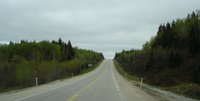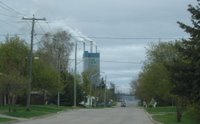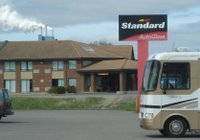Raindrops Keep Falling on My Head
May 10, 2006
We awoke to a ‘Vancouver morning’ – overcast and wet. As we pulled up stakes to move on, the elderly couple that greeted us on arrival drove up to wish us the best on our travels. It amused me to see them dressed in their parkas. I asked them if they were expecting snow and they said, “You never know”.
Gas is getting cheaper as we drive east. This morning at Safeway in Winnipeg it was only $1.009/litre; that’s the cheapest so far. I believe it’s much higher in the Maritimes though so I won’t take it for granted.
About sixty kilometres east of Winnipeg, farmland came to an abrupt halt and forests of birch, aspen, jack pine and black spruce took over. Highway 1 runs right through Sandilands and Whiteshell Provincial Parks, which protect the fragile ecosystem of the glacially carved rocky Canadian Shield. The shades of the woodland made for an artist’s palette of greens. Grassy medians dotted with bogs of reeds and bulrushes, divided the highway. West Hawk Lake on the Manitoba/Ontario border formed by a crashing meteor some million or billion years ago is on the western edge of Ontario’s lake district. The other thousands of lakes were created by glacial depressions and thus not as deep.
Sandilands and Whiteshell Provincial Parks, which protect the fragile ecosystem of the glacially carved rocky Canadian Shield. The shades of the woodland made for an artist’s palette of greens. Grassy medians dotted with bogs of reeds and bulrushes, divided the highway. West Hawk Lake on the Manitoba/Ontario border formed by a crashing meteor some million or billion years ago is on the western edge of Ontario’s lake district. The other thousands of lakes were created by glacial depressions and thus not as deep.
We stopped in Kenora, a tourist town on the north end of Lake of the Woods. Big signs lined the Walmart parking lot, “No Overnight RV Parking by City Ordinance”. I guess we know when we’re not welcome, so we carried on. Can’t blame Walmart.
“Lake of the Woods” is a misnomer; it was actually called “Lake of the Islands” by the Ojibway because of the thousands of islands. The French came along and didn’t understand the Ojibway language and thought they said ‘woods’ instead of ‘islands’.
The landscape started to become extremely monotonous – trees and lakes for mile after mile. We started to wish we could see a grain elevator on the horizon. We were happy when we approached the town of Dryden and signs of civilization broke the monotony.
Dryden, in what is called ‘northern Ontario’ (I would call it Western Ontario) is a pulp mill town. People are born there, work and die there. The belching smoke from the triple chimneys is visible from wherever you are in town. It’s the centrepiece and life revolves around it. A visit to Tim’s for a steeped tea was a rurally cultural experience. It was filled with men either just getting off shift at the mill or just about to start.
the triple chimneys is visible from wherever you are in town. It’s the centrepiece and life revolves around it. A visit to Tim’s for a steeped tea was a rurally cultural experience. It was filled with men either just getting off shift at the mill or just about to start.  They all wore the same style of clothing – ball caps with various logos (which they didn’t remove at the table), jeans, work boots and down vests or jackets. There was a chorus of “Hi Joe” – “Hi Bob” – Hi Doug” as new members joined their groups. The only women to be seen were the Tim’s workers.
They all wore the same style of clothing – ball caps with various logos (which they didn’t remove at the table), jeans, work boots and down vests or jackets. There was a chorus of “Hi Joe” – “Hi Bob” – Hi Doug” as new members joined their groups. The only women to be seen were the Tim’s workers.
There’s a Walmart in Dryden, so of course we pulled in; no signs on the fence and the woman in the Walmart Gas Station suggested we pull our motorhome around the side of the store to avoid the scores of transport trucks that pulled in and out all night. Across the road at the Superstore, there were large signs similar to those in Kenora that Dryden doesn’t allow overnight parking within the city limits. So we went to bed hoping the police wouldn’t wake us.
We awoke to a ‘Vancouver morning’ – overcast and wet. As we pulled up stakes to move on, the elderly couple that greeted us on arrival drove up to wish us the best on our travels. It amused me to see them dressed in their parkas. I asked them if they were expecting snow and they said, “You never know”.
Gas is getting cheaper as we drive east. This morning at Safeway in Winnipeg it was only $1.009/litre; that’s the cheapest so far. I believe it’s much higher in the Maritimes though so I won’t take it for granted.
About sixty kilometres east of Winnipeg, farmland came to an abrupt halt and forests of birch, aspen, jack pine and black spruce took over. Highway 1 runs right through
 Sandilands and Whiteshell Provincial Parks, which protect the fragile ecosystem of the glacially carved rocky Canadian Shield. The shades of the woodland made for an artist’s palette of greens. Grassy medians dotted with bogs of reeds and bulrushes, divided the highway. West Hawk Lake on the Manitoba/Ontario border formed by a crashing meteor some million or billion years ago is on the western edge of Ontario’s lake district. The other thousands of lakes were created by glacial depressions and thus not as deep.
Sandilands and Whiteshell Provincial Parks, which protect the fragile ecosystem of the glacially carved rocky Canadian Shield. The shades of the woodland made for an artist’s palette of greens. Grassy medians dotted with bogs of reeds and bulrushes, divided the highway. West Hawk Lake on the Manitoba/Ontario border formed by a crashing meteor some million or billion years ago is on the western edge of Ontario’s lake district. The other thousands of lakes were created by glacial depressions and thus not as deep.We stopped in Kenora, a tourist town on the north end of Lake of the Woods. Big signs lined the Walmart parking lot, “No Overnight RV Parking by City Ordinance”. I guess we know when we’re not welcome, so we carried on. Can’t blame Walmart.
“Lake of the Woods” is a misnomer; it was actually called “Lake of the Islands” by the Ojibway because of the thousands of islands. The French came along and didn’t understand the Ojibway language and thought they said ‘woods’ instead of ‘islands’.
The landscape started to become extremely monotonous – trees and lakes for mile after mile. We started to wish we could see a grain elevator on the horizon. We were happy when we approached the town of Dryden and signs of civilization broke the monotony.
Dryden, in what is called ‘northern Ontario’ (I would call it Western Ontario) is a pulp mill town. People are born there, work and die there. The belching smoke from
 the triple chimneys is visible from wherever you are in town. It’s the centrepiece and life revolves around it. A visit to Tim’s for a steeped tea was a rurally cultural experience. It was filled with men either just getting off shift at the mill or just about to start.
the triple chimneys is visible from wherever you are in town. It’s the centrepiece and life revolves around it. A visit to Tim’s for a steeped tea was a rurally cultural experience. It was filled with men either just getting off shift at the mill or just about to start.  They all wore the same style of clothing – ball caps with various logos (which they didn’t remove at the table), jeans, work boots and down vests or jackets. There was a chorus of “Hi Joe” – “Hi Bob” – Hi Doug” as new members joined their groups. The only women to be seen were the Tim’s workers.
They all wore the same style of clothing – ball caps with various logos (which they didn’t remove at the table), jeans, work boots and down vests or jackets. There was a chorus of “Hi Joe” – “Hi Bob” – Hi Doug” as new members joined their groups. The only women to be seen were the Tim’s workers. There’s a Walmart in Dryden, so of course we pulled in; no signs on the fence and the woman in the Walmart Gas Station suggested we pull our motorhome around the side of the store to avoid the scores of transport trucks that pulled in and out all night. Across the road at the Superstore, there were large signs similar to those in Kenora that Dryden doesn’t allow overnight parking within the city limits. So we went to bed hoping the police wouldn’t wake us.

0 Comments:
Post a Comment
<< Home